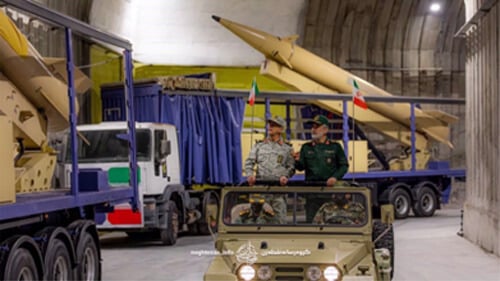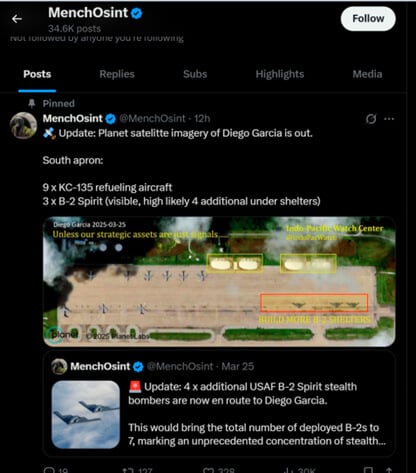Tensions Rise in the Northern Indian Ocean as Iran Stages Display

While US forces continue to pummel Houthi targets in Yemen, primarily using aircraft launched from the USS Harry S. Truman Carrier Strike Group located in the Red Sea, tensions at sea are also rising in the Northern Indian Ocean. Signs of increased military readiness are evident both on the part of Iran and of the United States.
In comparison with the normal level of anti-American rhetoric seen on a daily basis in the Iranian online press, which is dominated by government-controlled websites, recent days have seen a dramatic increase in stories that imply that the Iranians feel they are under imminent threat. These stories are normally pitched as warnings to both America and Israel not to attack, brandishing Iran’s ability to counter-attack using its drone and ballistic missile forces. At times of tension, Iran often manufactures a display of some new missile capability, and in recent days has shown off what it claims is a new underground tunnel complex; in this instance, the story may be true, as similar tunneling, albeit with the normal complement of missiles on mobile launchers, has not been seen before.

Major General Mohammad Bagheri and Brigadier Amir Ali Hajizadeh tour the new ‘missile megacity’, March 25 (Press TV)
In an underwhelming display on March 27, the IRGC Navy (Nedsa) mounted a parade of old and unarmed dhows along the length of its coastline, which it said included vessels from Lebanon, Iraq, and Yemen. A number of the trading vessels are likely to have been contracted by Nedsa’s Unit 190 in recent years to smuggle weapons to the Houthis and others. This somewhat pointless review, which was probably the ‘3000 boat event' originally planned for January 27, was led by the converted oil tanker Shahid Bagheri (C110-4) and the Shahid Soleimani Class missile corvette Shahid Rais Ali Delvari (FS313-04).
The Regular Iranian Navy (Nedaja) is adopting a slightly more relaxed posture during the Ramadan season. On March 28, satellite imagery of the main naval base at Bandar Abbas showed four Alvand/Moudge and one Bayandor frigates alongside. There was no sign in the harbor of the intelligence collection frigate IRINS Zagros (H313). A Kilo Class submarine was at its berth on the east side of the harbor, with a second Kilo seen in dry dock. The long-range logistic vessel IRINS Makran (K441) was at its normal pier in the outer harbor. The three operational Hengham Class amphibious ships were alongside, together implying that there are no long-range flotillas out of home waters at present, as these vessels normally provide logistic support for such deployments. It is not clear at present even if the Nedaja remains in the Red Sea and Gulf of Aden area, a station which it has been maintaining continuously since 2008; if present, what would be the 101st Flotilla is maintaining an extremely low profile.
With the U.S. negotiating position outlined to Iran in a letter passed by President Trump through intermediaries to Supreme Leader Ali Khamenei, the Iranians understand they have limited room for maneuver and are under increasing pressure. At the same time, both the European Union and the United States have significantly tightened sanctions on the dark tanker fleet running sanctioned Iranian oil exports, which will have immediate detrimental effects on an Iranian economy already under very significant strains. On March 13, the US Treasury sanctioned an additional 30 tankers, in the third round of such sanctions. The EU’s 16th sanctions package listed an additional 73 Russian and Iranian tankers.
On the other side of the balance sheet, the United States is significantly reinforcing its strike capability in both the Red Sea and Northern Indian Ocean areas.

Imagery of Diego Garcia on March 25, sourced from @IndoPacWatch but reposted by @MenchOsint who is often sympathetic to Iran
Recent satellite imagery shows at least seven B-2 Sprint strategic bombers on the British base at Diego Garcia. Nine KC-135 refueling aircraft are also visible on the southern-most ramp, with slots B1 and B2 on the ramp closed to other visiting military aircraft until the end of April. The KC-135 refuellers provide a significant payload and range boost, as they can refuel both the B-2 Sprints, the F-18 strike aircraft launching from the USS Harry S. Truman Carrier Strike Group, but also those from the USS Carl Vinson Carrier Strike Group which is tracking west, and due to arrive in the area shortly.
Early on March 28, the MV Jairan, the second of two sanctioned Islamic Republic of Iran Shipping Lines (IRISL) carrying sodium perchlorate from China, arrived in the Bandar Abbas anchorage. It can be expected to now move into the inner harbor and unload its cargo, to be processed into ammonium perchlorate which is the basis of the solid fuel which powers most of Iran’s medium-range ballistic missiles.
